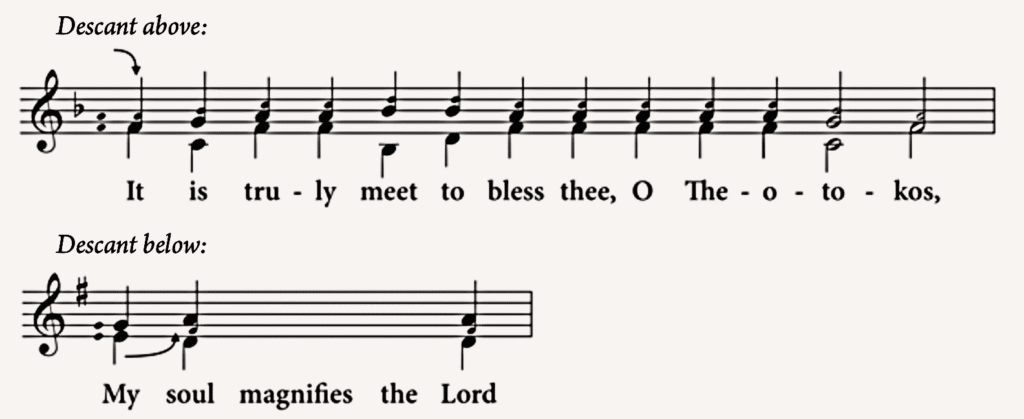 Note: This article is taken from A Common Book of Church Hymns: Divine Liturgy (ed. B. Sheehan; STM Press, 2016). It is provided here as a guide to harmonizing the two part music scores from both of St. Tikhon’s Common Books of Church Hymns, Divine Liturgy and Great Vespers, which are offered on this site.
Note: This article is taken from A Common Book of Church Hymns: Divine Liturgy (ed. B. Sheehan; STM Press, 2016). It is provided here as a guide to harmonizing the two part music scores from both of St. Tikhon’s Common Books of Church Hymns, Divine Liturgy and Great Vespers, which are offered on this site.
Bound volumes of these publications may also be purchased at stmpress.com »
How to Harmonize
The core of Orthodox liturgical music — and arguably of music generally — is melody, and this book is above all a collection of melodies. The simplest way to use this book is to sing only the melody, which is always to be found in the upper voice on the staff.

However, while all the music in this volume is printed on one staff in either one or two voice-parts, this does not mean that this is necessarily a book of unison or two-part music. Many of the melodies contained herein — Common Chant and Kievan Chant, for example — were likely never meant to stand alone, but were customarily harmonized according to simple four-part formulas. Slavonic obikhods of previous centuries usually contained only a single melodic line, and singers were expected to harmonize the chant melodies by ear. This is a reasonable expectation where there exist well-established traditions of harmonized singing, but in English-speaking North America, where Orthodox faithful are often either clinging to the vestiges of a tradition that only their grandparents knew firsthand, or are encountering this tradition for the first time as adults, harmonizing chant melodies at sight can be challenging. In order to make adding harmony to the melodies in this book easier, I have included a functional bass part for all the chants that are customarily harmonized. After the melody, therefore, the bass may be added as a supporting part and as a guide for inferring the rest of the harmonies.

Singing only melody and bass is one option if that is what available forces permit. However, if the singers are available, it is customary to add a descant, which usually takes the form of a parallel third either above or below the melody. At the head of each staff I have included small courtesy notes in order to indicate the location of the descant—i.e., above or below the melody—as well as to help the choir director or cantor know what pitches to give the singers before starting. If the descant is above the melody (by far the more common circumstance) the upper courtesy note will be higher than the starting note of the melody; if the descant is below the melody, the upper courtesy note will be the same as the starting note of the melody.

Depending on the forces available, the descant may also be sung by a tenor, for example, with a soprano singing the printed melody. In this case, the tenor would sing a third above the printed melody, but in his own register, thus rendering harmony a sixth below the melody.

It should be noted that in some instances the best sounding harmony for the descant singer to use is not a strict parallel third. I have tried to indicate those places by placing courtesy notes above or below the melody. To avoid cluttering up the score, however, I have used such courtesy notes minimally, so the singer will have to infer the same patterns for any other similar instances in a given hymn.

The fourth and last voice part that may be added to any formulaic harmonization of chant is called the filler part. Filler is precisely what it sounds like: it fills in the missing notes of a given chord. Unlike the descant, which mostly parallels the contour of the melody, or the bass, which also usually moves with the melody, the filler tends to be a relatively static part. However, its role is pivotal in making a four-voice texture sound rich and full, as well as serving as an anchor for the other voices. In a mixed choir the filler part is almost always performed by one of the inner voices. For example, when the melody is being sung by the soprano with tenors singing the descant, the filler part would normally be sung by the alto.

Conversely, if the melody is being sung by the alto, and the soprano therefore has the descant, the filler part would be be sung by the tenor.

It may occur that an ensemble will be made up entirely of equal voices—i.e., only women’s voices or only men’s voices—as is frequently the case in monasteries. In this case, the simplest and most reliable solution is to sing with only three voice parts: melody, descant, and bass, and to leave the filler part out.

In some cases with equal voices, if the singers are available, the filler part may be added, provided it does not drop below the bass. A filler part that frequently ends up below the bass will make for irregular chord voicings and unstable harmonies. The following is to be avoided:

Instead, depending on the vocal range of the singers, the bass may in this case drop down to the octave below in order to make room for the filler part.

If the above is not possible, then the filler should be left out of the chord and should simply resolve upwards to a unison with the bass.
All in all, the most practical and satisfying approach to harmonizing chant in a small ensemble is to keep it simple, to let it be flexible, and to do whatever is necessary for the melody to be strong and stable. The present volume is designed to help church singers do precisely this. In the near future we plan to release four-part scores for mixed choir of all the music in this book, so for choirs that routinely have enough capable voices, fully harmonized music will—God permitting—be available in due course.
